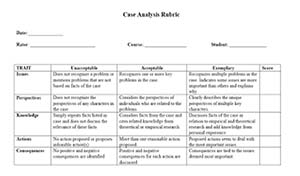INNOVATIVE TEACHING SHOWCASE
IDEAS
Idea 10: Inquiry-based Learning (IBL) Rubric Development Guide
“Rubrics are a powerful tool for supporting learning by guiding learners’ activities and increasing their understanding of their own learning process.”2
Learning Intention
Rubrics help students recognize learning goals and guide them in reaching for those goals. Particularly useful in student-directed teaching approaches, like inquiry-based learning, rubrics can be used to assess content mastery, skill development, or even attitude toward a topic.
Overview
Developing a rubric involves clearly identifying and articulating specific outcomes of learning and structuring those criteria in an easy-to-use format that serves as a reference tool in guiding learning and an assessment tool for evaluating success. In inquiry-based instruction, faculty can work collaboratively with students to develop the rubric, or integrate the rubric by distributing it as part of the assignment description and/or for students to use in peer- or self-assessment.
Instructions
- Reflect on Expectations:1,2,3 Why did you create the assignment? Define what you hope students will learn and how you expect students to show mastery.
- Identify Distinct Criteria: List specific details or dimensions of the assignment you will target in your assessment. Look for categories or groups and label them.
- Determine Levels: Set your range and scoring scales, usually between 3 and 6 levels. Your levels can be qualitative (descriptive only) or quantitative (point values). Some quantitative rubrics use a range of numbers for each level; others use a set value for each level.
- Clearly describe each level of achievement for each criteria: It is helpful to start at the bottom and top (What does mastery look like? What is unacceptable?) and work your way toward the middle.2
Considerations
- If you want to build a rubric yourself, a Rubric Template or an Online Rubric Generator will be helpful!
Example

- Developing Rubrics (Assessment Criteria). Committee on Assessment of Student Learning at University of Illinois, Springfield. Available online.
- Mullinix, B. B. (2014). Rubrics. The TLT Group: Teaching, Learning and Technology. Availble online.
- Kasper, B. (no date). CTE Tip: What is a Rubric? Center for Teaching Excellence, SUNY Plattsburgh. Available online.
- Stevens, D. (2009) Rubrics: An assessment tool to save grading time, to engage students ... Assessment Office, University of Hawai’i, Manoa. Available online.
- Teaching Tips: Rubrics (no date) Center for Instructional Innovation & Assessment at WWU. Available online.


